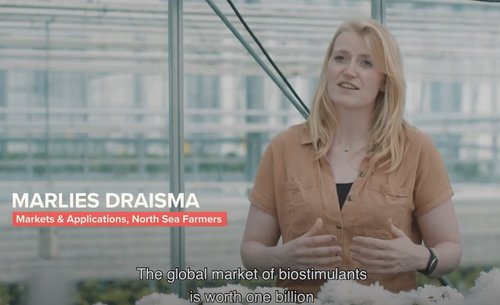The end of Bio4safe: the start of EU seaweed biostimulants
2021-05-03
After 4 years of Bio4safe, the project is almost coming to an end. Though the trials on crops will continue until summer, we have published our final report. That kind of feels like the end of an era for our team. All project partners stepped in this project without knowing what to expect and ended up with truly relevant outcomes for both farmers and seaweed farmers. That’s a major accomplishment! So what was this project like for us? And what’s next?
From the beginning, this was a unique project. Seaweed wasn’t the lead character here, but the overburdened European agricultural sector was. A sector which is in need of climate solutions in various ways. Truth be told, we did feel like the odd man out here a little. The other project partners knew more about biostimulants and its potential for agriculture than we did. But the determination of those researchers to find agri-solutions, was something we recognized.
 We knew that seaweed was used for this biostimulant purpose, especially in Asia where climate issues are even more severe than in Europe. Up to 4 years ago, there was little to no record on the effectiveness or usability of European seaweed for this application. And that was exactly the reason for us to get on board in this project: we were extremely curious if European seaweed could play a role in climate solutions on land. If it could not, then that would be okay; there’s other roles to play for seaweed. But if it could, then this would strengthen our mission and underline the urgency to start cultivating European seaweed.
We knew that seaweed was used for this biostimulant purpose, especially in Asia where climate issues are even more severe than in Europe. Up to 4 years ago, there was little to no record on the effectiveness or usability of European seaweed for this application. And that was exactly the reason for us to get on board in this project: we were extremely curious if European seaweed could play a role in climate solutions on land. If it could not, then that would be okay; there’s other roles to play for seaweed. But if it could, then this would strengthen our mission and underline the urgency to start cultivating European seaweed.
The main project question of Bio4safe – can biostimulants combined with plant sensors help reduce water & fertilizer input on land or in greenhouses and if so, how? – was a complex question to solve. It required intense collaboration, extensive research and action for implementation. That’s why the project started with 8 different partners, across 4 countries in North-west Europe (while speaking 3 different languages), including prominent agri- and horticultural researchers, scientists from research institutes, developers who create tool for farmers and growers, consultants in the agri-sector and sector organizations such as ourselves. We wanted to not only extend our knowledge with evidence-based research, but also to make that knowledge applicable for farmers and growers.
In the research, one of the most surprising findings may have been the impact of monitoring crops. The project showed that it is already possible to drastically reduce water inputs by monitoring a plant with sensors and meet the needs of that plant more specifically; without any other intervention. That was an eye-opener for us all. For North Sea Farmers the biggest achievement was setting up the pilot in which we developed a Bio4safe-only biostimulant based on European seaweed. We shipped seaweed from Norway to the Netherlands for processing and tested it as a biostimulant on strawberries, chrysanthemums and other crops. It performed well. Just as well (and sometimes even better!) as the commercial biostimulants. That, we did not expect to see. But you can imagine: we were ecstatic.
Of course these last 4 years have not been hallelujah only. All partners encountered some difficulties along the way. Intensive collaboration across borders is, especially in COVID times, not easy. It requires more time, patience and effort to keep moving forward together. One project partner had to step out unfortunately. Those are tough decisions to make for everyone involved.
As the project continued, more and more stakeholders became interested in following the outcomes as they feel the need for (sustainable) climate solutions for their crops. We met biostimulant producers, processors, sector organizations, famers, policy maker and – in our case – seaweed farmers: a large value chain with many stakeholders and just as many interests. From our part, it required more energy facilitating engagement across the value chain and work on a support base for the implications of this project. We spoke to more than 1,500 people in various workshops, webinars, leaflets and others: to inform, engage and prepare on what’s next in the biostimulant world.
So, what’s next with seaweed based biostimulants - with the demand for biostimulants rising each year? And with the highly motivated people we have met during this project? We strongly believe this is the start of a new value chain: European seaweed for biostimulants. However, we do need more work on this topic to validate that. You can read all about our findings, conclusions and recommendations for next steps in the latest (and final) report here: (LINK).
The fact that this project added another climate solution to the list of potential European seaweed applications is just something we could not have expected. Needless to say, we are excited about it! Scaling up seaweed production in Europe seems to be, once again, a logical step in the future of climate solutions; also on land. How about that?
If you have any questions on this topic or project, feel free to contact us. Or better yet: join us! And become part of the sustainable European seaweed sector.
Related links:
Project video on Bio4safe results
Video on the North Sea Farmers Bio4safe European biostimulant pilot
Visit the database: www.bio4safe.eu
Final Bio4Safe report: feasability study and market research (January 2021)


